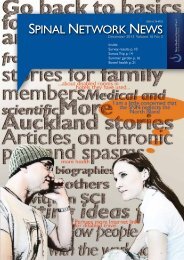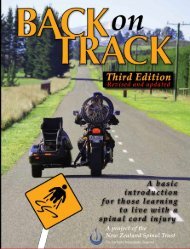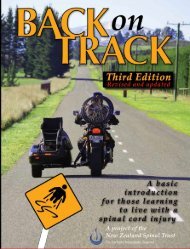SPINAL NETWORK NEWS
You also want an ePaper? Increase the reach of your titles
YUMPU automatically turns print PDFs into web optimized ePapers that Google loves.
SAMOA<br />
Trip 2013<br />
In 2012, a team of health professionals from New Zealand<br />
travelled to Samoa with the goal of empowering people with<br />
a SCI to manage their health conditions. In August 2013, a<br />
team consisting of many of the same people conducted a<br />
follow-up trip to Samoa to see the people from the previous<br />
year and new clients with a SCI. Again, the aim was to impart<br />
knowledge and education to individuals with a SCI and their<br />
families, to help them manage the consequences of their<br />
injuries. I caught up with three members of that team from<br />
the Burwood Spinal Unit to find out about the experience:<br />
Maria van der Heuvel, a clinical nurse specialist; Marian<br />
Lippiatt, a nurse; and Annie Jones, a physiotherapist. In total,<br />
there were seven members in the team, who all travelled<br />
voluntarily and paid their own way, with some subsidy from<br />
Altus Resource Trust for accommodation.<br />
Maria has visited Samoa for the past three years, but for<br />
Marian and Annie, this was their first time on a trip like this.<br />
For Marian, the key motivation was to impart knowledge<br />
to the individuals with a SCI; their family members; and the<br />
health professionals: “(I wanted) to share knowledge about<br />
bladder management, pressure- area management, and bowel<br />
management… I got a shock at how basic things were,<br />
with no rehabilitation or home visits.” Annie had all always<br />
wanted to do volunteer work and, what really appealed to<br />
her, was the potential to help create long-term change: “it<br />
wasn’t like we were going across and then just coming back;<br />
it sounded like there was a whole programme being set up,<br />
and that really appealed to me – we were trying to build<br />
knowledge and work with the locals.”<br />
The team was in Samoa for just over a week and split into<br />
two groups in order to see as many people as possible in<br />
the short time they were there. Maria said they managed to<br />
spend around an hour with each client. During this trip, Maria<br />
saw the benefits of previous trips: “the majority of people<br />
who were in the new client category last time, are now free<br />
of pressure sores, they’re doing transfers properly, and have<br />
good bowel management. They’re even starting to teach<br />
others with a SCI.” Maria suggests that the individuals in<br />
Samoa are very receptive to knowledge and are very thankful<br />
when the New Zealanders come to visit.<br />
The time available for each visit was limited, and Annie<br />
described the visits as “trying to fit six months of<br />
rehabilitation into 1 or 2 hours.” At the start of each visit,<br />
the team would assess bladder, bowel and skin status, then<br />
discuss the management options available for each of these<br />
14
















